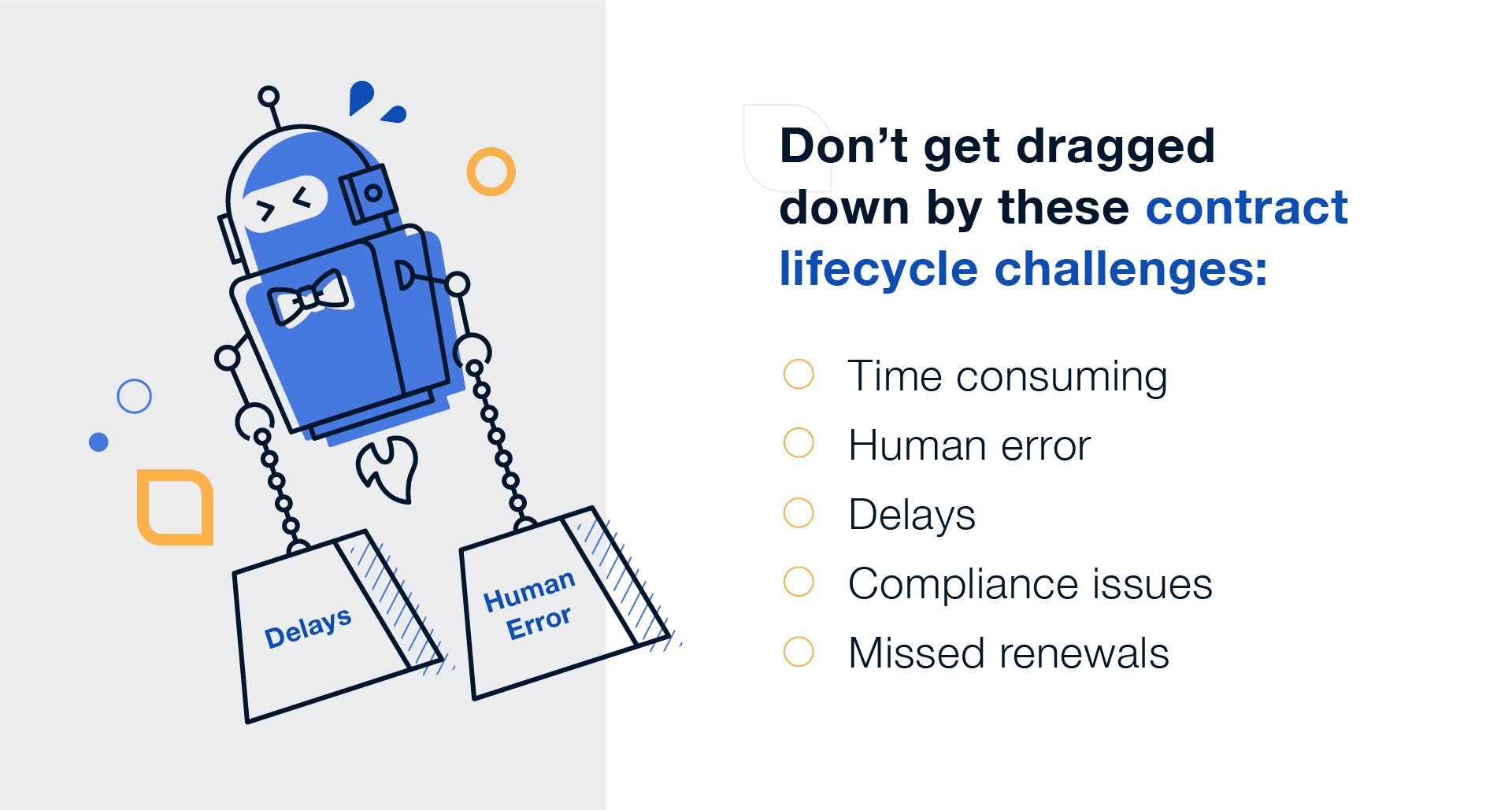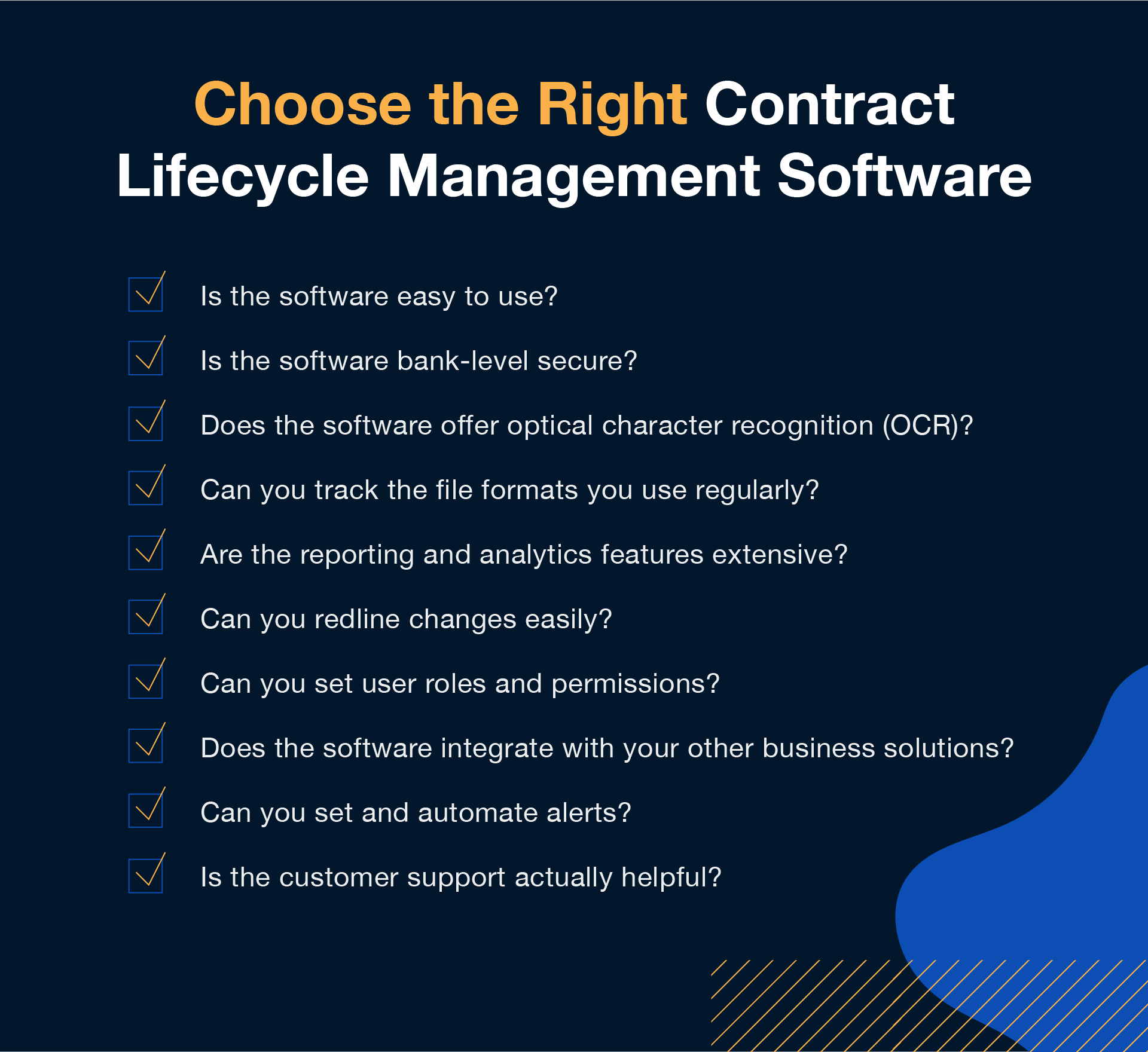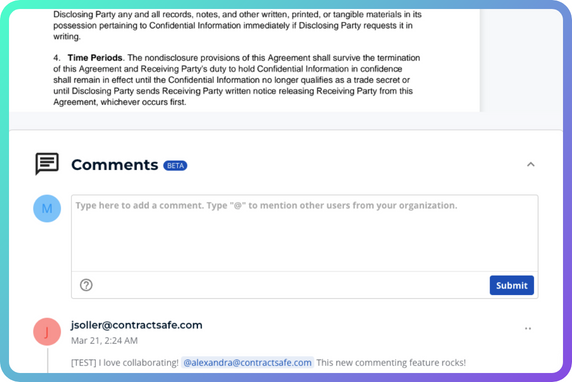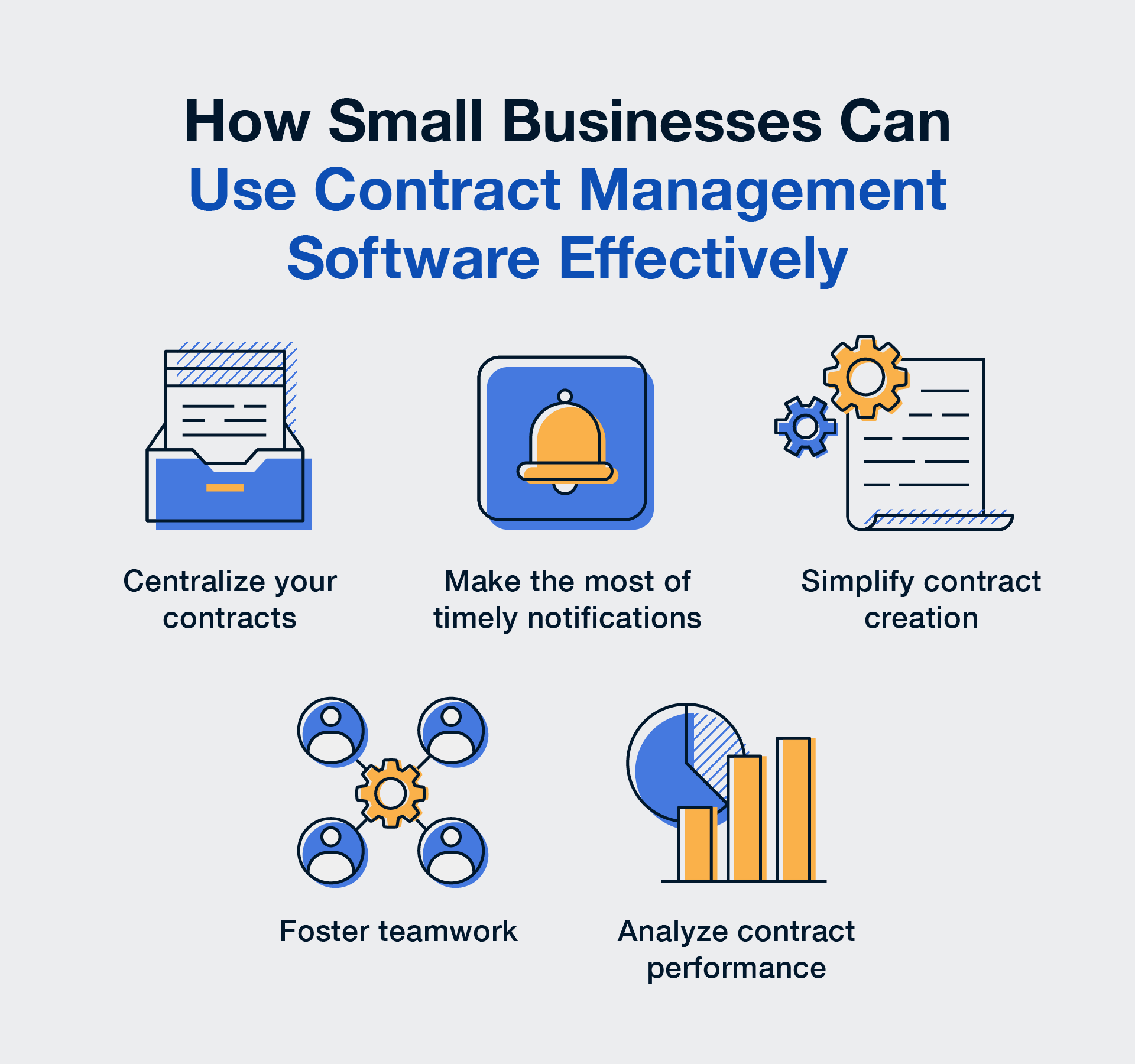Contract lifecycle management isn’t a great dinner party topic. But the success of your business could depend upon doing it well.
Keeping track of a ton of contracts is a genuine concern for any industry. And the consequences of missing an important contract date can be huge.
Just ask Park City Ski Resort.
In “one of the most monumental blunders in Utah business history,” they lost their entire mountain because they forgot to renew their contract.
It can happen to anyone. (Yes, anyone.) But contract lifecycle management (CLM) can help.
Contract lifecycle management is an essential process that helps organizations manage and govern their contracts and, most importantly, not pull a Park City.
Combine that process with software and you’ve got a recipe for streamlined, error-proof contract management that lowers risk and saves you money.
But with all the jargon surrounding contracts, learning about contract management has become way harder than it needs to be.
In this post, we'll discuss what contract lifecycle management is, why it's important, and outline steps you can take to implement a simple but effective contract lifecycle management solution.
TL;DR
- Contract lifecycle management simplifies everything from drafting and negotiation to approval and execution and beyond.
- Contract lifecycle management keeps all important information at your fingertips, from where things are in the process to contract milestones. Keeping team members in the loop has never been easier.
- A CLM system can help reduce risk, save money, and keep the regulators at bay.
What Is Contract Lifecycle Management?
Simply put, contract lifecycle management starts with the creation of a contract and ends when all conditions have been met, or the contract is terminated.
It’s a process that can help keep productivity high, reduce risks, and, most importantly, save your company cold hard cash.
In practice, contract lifecycle management is often accomplished using contract management software. This software allows users to search and find, organize, share, and report on contracts without the need for messy drives or a dusty filing cabinet.
Learn if CLM is right for your business with our easy-to-use contract management software ROI calculator.
Why Contract Lifecycle Management Is Important
Managing contracts isn’t always easy.
Different stages of the contract lifecycle bring different challenges:
- Time-consuming: Filing, storing, and keeping contracts secure takes time and resources.
- Human error: Inaccuracies and missed deadlines and signatures are almost always due to human error.
- Delays: Waiting on contract approval can hold up projects and lead to frustrated vendors or customers.
- Compliance issues: Poor contract management and monitoring could lead to policy compliance issues, costing your business money and legal trouble.
- Missed renewals and other dates: Not keeping up with renewal deadlines or other key milestones could cost you money or lead to a lapse in contracts with your vendors, negatively impacting your business’s performance.

Having a CLM system can help with all of these contract management challenges and more.
What Are the Stages of Contract Lifecycle Management?
The lifecycle of a contract is a lot like making dinner. It can be broken down into two parts: pre-signature (cooking) and post-signature (eating). Within these parts, there are six distinct stages.
Much like cooking starts with gathering your ingredients and ends with serving food, the pre-signature process starts with contract creation and ends once the contract is signed. These stages include:
- Contract creation
- Contract negotiation and collaboration
- Contract review and approval
Now, on to the fun part: eating. The post-signature processes take place after the contract is signed and continue until the contract expires or is terminated. These stages include:
- Contract administration and execution
- Contract renewal or termination
- Contract reporting and tracking
We know — it can be a mouthful. So let’s break contract lifecycle stages into bite-size pieces below:
1. Contract Creation
Most dinners begin with a need: hunger. A contract’s lifecycle begins when your business needs to enter into a legal agreement.
Before you can get cooking on your contract, your attorney needs to understand why the contract is being created and what to include to ensure expectations are met.
Contract ingredients can include things like:
- Start dates
- Pricing
- Project milestones
- Other relevant clauses that need to be outlined
But it’s not easy to come up with dinner from scratch, so many companies use a contract management platform that records key details ahead of time to make it easy to create contract requests. Chefs call it mise en place — we call it easy-to-use, streamlined contract management.
After getting the contract request ready to go, the contract attorney cooks up the initial draft (sometimes using a template) and customizes it based on what’s needed.
2. Contract Negotiation and Collaboration
The first time cooking a recipe usually isn’t perfect. Maybe you added too much salt, or it could use a little more garlic next time. Similarly, after nailing down the first draft of a contract, you can expect there’ll be some degree of contract negotiation.
This involves legal teams taking turns to redline the agreement with requests and changes until everyone’s happy.
This process typically takes place in Word and is sent around via email. But like your grandma’s recipe book, that can be a bit dated and difficult to keep track of.
Instead of parsing through disorganized email chains or shared drives for the most updated contract, you’d likely prefer a contract management platform that keeps track of edits and changes for you. That way, you’ll never have to worry about working on an outdated version. No secret ingredients gone missing here!
3. Contract Review and Approval
Once you’ve fine-tuned your contract, it’s time to get the suits involved.
Getting a contract signed involves both approvals and signing. Approvals refer to getting internal sign-offs, while signing is when you actually put the ink on paper.
Approval chains tend to happen using ticketing systems or emails. Roles that are commonly involved in this process include:
- Legal teams
- Business leaders
- Project managers
- Key stakeholders
The process can be compared to herding sheep. (But don’t tell anyone we said that.)
A contract management platform, however, is like a prized sheepdog. Not only can it help wrangle wandering executives, but it can also separate the approval and signature processes and make sure rogue versions aren’t making the rounds.
4. Contract Administration and Execution
The internal approval stage is where contracts are signed by all of the parties involved, and agreements are sent to everyone who needs a copy.
Contract management platforms let you do this family style by sending the document around to everyone who needs to sign off and letting them serve themselves.
While approvals can involve multiple key stakeholders, contract execution typically involves only two parties: you (or a representative of your organization) and your counterparty.
Once internal approvals are squared away, it’s time to sign the contract. To cut down on cooking time, most companies use a generated digital signature or an e-sig platform like DocuSign or Dropbox Sign to fill in signatures with just a couple clicks.
5. Ongoing Contract Management and Renewal
Dinner is served, but your work’s not done just yet. Much like washing dishes as you cook, you can set yourself up for success with ongoing contract management.
This happens between signature and renewal until compliance and obligations are met, and includes things like:
- Tracking contract milestones
- Performing periodic contract audits to verify compliance
- Tracking contract changes or amendments
- Searching and finding key contracts
- Limiting access based on user clearance levels
These files should also be stored in an easy-to-access location like a central document repository (bonus points if it’s cloud-based). That makes it easy to find for anyone who swears they bookmarked the recipe but just can’t seem to find it.
It is worth noting that these docs better be secure! You don’t want any confidential information falling into the wrong hands.
All of these factors will ultimately play a role in whether the contract is renewed or terminated.
This stage requires Marie Kondo-level organization. Some contracts have terms you’ll need to stay on top of, like auto-renewals (with price hikes) or option dates (Park City, anyone?).
That’s why it’s key to effectively manage your contracts throughout their lifecycle. Missed contract dates can lead to a pileup of financial, legal, and procurement risk, while contracts that auto-renew before a business has a chance to review or renegotiate can result in price creeps.
6. Contract Reporting and Tracking
Throughout the life of a contract, there’ll be a ton of reports you’ll need to generate, including:
- Compliance reports
- Performance reports
- Status reports
If you didn’t have to do dishes manually, why would you? Similarly, contract management software takes the hard work out of reporting and tracking. You just need to set it up and wait for that shiny clean data at the end of the cycle.
Additionally, contract tracking verifies that everyone involved in the contract lifecycle is aware of how far along it is in the cooking process — and that everyone can access what they need when they need it.
It can also make sure that milestones are met, and that all parties are doing what they’re supposed to be doing.
Don’t take our word for it: Research conducted by the International Association for Contract and Commercial Management (IACCM) has shown that good contract development and management can improve profitability by up to 9% of annual revenue. The takeaway is clear: Contract management should be as simple and streamlined as possible.
Benefits of Contract Lifecycle Management Software
Contract lifecycle management software is like your sous chef. It helps automate and facilitate the contract lifecycle while making sure you’re compliant with organizational policies. In other words, it takes care of the little tasks (and some big ones) so you can focus on the big picture.
Let’s dig into some other ways contract lifecycle management software can benefit you.
Save Time and Standardize Contract Creation
Contract lifecycle management software automates and standardizes tasks such as contract generation, approvals, signature collection, renewals, and reporting.
This will free up time for you and your team to focus on more important things, like what to order for lunch, or catch up on those memes your colleague has been sending all morning.
Simplify Negotiations
With contract lifecycle management software, you can easily track and manage contract terms and conditions, redline edits, and maintain a single source of truth between multiple parties.
This will give you a crystal clear overview of your company’s obligations and make the negotiating process a breeze.
Streamline Contract Approvals
By automating tasks such as routing and notifications, you can be sure that contracts are approved in a timely and efficient manner.
Improve Security and Compliance
Contract lifecycle management software can help you improve security and compliance by providing a central document repository for all your organization's contracts.
This will help you stay on top of key expiration dates, renewals, and amendments so your soufflé doesn't collapse
Reduce Administrative Costs
By automating repetitive tasks and improving efficiencies, contract lifecycle management software can help reduce the overall costs associated with contract management.
Mitigate Risks and Reduce Contract Noncompliance
Contract lifecycle management software can help avoid risks that arise during the contract lifecycle.
Good software will help you make sure all your i’s are dotted, and all your t’s are crossed. It’ll also help ensure that only the people who need to have access to the contract have access to it.
Search and Find Key Contracts
Finding the right contract out of thousands can feel like searching for a grain of rice in, well, a bag of rice. Good contract lifecycle management software is like a magnet for your contracts — spend less time searching through endless pages of documents, and instead let the documents come to you.
Improve Reporting
Does one-size-fits-all ever really work? The same can be said for reporting. Highly standardized reporting templates can be hard to configure for your specific needs. Contract management software can analyze reporting metrics to tell you the most important things to know when you need to know them.
Who Uses CLM Software?
Contract lifecycle management isn’t just the responsibility of a single department. It spans multiple teams and dozens of employees.
Developing a holistic view of the various teams involved and their respective roles and responsibilities can empower business leaders to determine the best strategy for streamlining the process.
- Legal: The legal team is responsible for protecting the business from unfavorable obligations or liability. They provide final approval on all agreements before they head to the next stage.
- Management: The management teams will be involved in the negotiation of business-specific terms such as pricing and the scope of work.
- Sales: Sales teams actively sell the products and services that require legal protection and governance. They need to inform legal and management of the services and terms agreed upon during the sales process.
- Business development: Business development teams responsible for large-scale growth initiatives, such as strategic partnerships or acquisitions, work closely with legal to confirm the terms of these deals are accurately captured from a contractual standpoint, as well as have an easy way to manage diligence processes.
- Finance: The finance team is responsible for ensuring the business is capable of fulfilling its contractual obligations from a budgetary standpoint. Pricing, payment terms, and billing requirements should all be communicated and approved by the finance team before the execution of any agreement.
- Procurement and sourcing: Like sales teams, procurement and sourcing departments must inform legal and management of the terms required for a specific agreement. They must also be aligned with business requirements and ensure they’re not agreeing to terms the business can’t support.
- Project managers: Project managers may be responsible for helping the legal team define project milestones or contractual obligations for projects they manage. They may also be focused on the general lifecycle timeline and ensuring that the document moves through the organization.
How To Choose the Right Contract Lifecycle Management Software
Contract lifecycle management software can make managing your contracts a cakewalk. But with so many options on the market, it can take time to choose the right CLM solution for your business.
Not sure where to start? Here are a few key features to search for when choosing contract management software:
Ease of Use
Software should be easy to use so that you can get started managing your contracts quickly and headache-free. This includes integrating with other platforms to make sure contracts can be added to your repository as is.
Common ease-of-use pitfalls include:
- Not considering your company’s specific needs. Many companies look for options with all the bells and whistles, not considering ease of use and implementation. Why spend months adopting an overcomplicated system with features you won’t use?
- Getting too many cooks in the kitchen. You start with a specific need and end up looping in more and more stakeholders. Before you know it, there’s a massive project with a high chance of failure, huge change management, sky-high costs, and zero happy campers.
- Not integrating with other platforms. CLM software needs to integrate with customer relationship management (CRM) or enterprise resource planning (ERP) systems. For example, industries like procurement often deal with many different types of contracts that are owned by vendors, so integration is key to minimize manual labor.
Security
Look for software that offers robust security features like data encryption and user authentication. In compliance-heavy industries like healthcare, contract management software can take the stress off adhering to strict data security and privacy standards.
Common security pitfalls include:
- Using software that is not ISO27001 and SOC2 certified, or software that does not encrypt viewing sessions. A breach of security could result in business-killing losses, distrust from clients, and even lawsuits.
- Using software that does not allow customized user roles and permissions. Without it, confidential documents may be viewed by people who do not have appropriate access, which may be a breach of HIPAA policy or other regulatory or compliance standards.
- Opting for software that is not hoste9d on the cloud. Local storage runs the risk of failing, and if files are not backed up, your firm may face a number of financial and legal headaches.
Search Functionality
Make sure the contract management software you choose uses optical character recognition (OCR). OCR can scan PDFs and images of contracts and turn them into searchable text.
But not all OCR is created equal. While some basic OCR software make single docs searchable, others (like ours)have a large index that allows you to search through thousands of documents to find what you need in just a few clicks.
Common search functionality pitfalls include:
- Looking for software that does not use OCR. Scanned documents may be saved as PDFs, which require a special type of processing to make them searchable.
- Relying on tags to search and locate contracts. Manually added tags and filters can be easily forgotten or mistaken, leading to nearly impossible-to-find documents. Automated search functionality allows users to find terms within and across documents — like your own personal Google search.
- Disregarding file formats. Documents aren’t always submitted in the same format, so CLM software needs to be able to scan and search a range of different formats.
Alerts and Reminders
Many contract management software programs offer features that let you track the status of your contracts. Look for a solution that works with all the file formats you use and gives reminders of more dates than just termination. And make sure you can send reminders and alerts through multiple platforms.
Common alert and reminder pitfalls include:
- Lack of push notification reminders. A lot of software will include reminders and alerts, but they may be limited to the dashboard and not be sent via email or SMS.
- No reminders for other key dates. Termination and renewals are some of the most important contract dates to remember, but there are other milestones you should be aware of ahead of time. Look for software that allows you to customize reminders down to the smallest task.
Reports and Analytics
CLM software should include reporting and analytics features that let you see how well your contract management process is working. Some software even uses artificial intelligence to create reports!
Common report and analytics pitfalls include:
- Low-quality reporting features. Lots of reporting systems are inflexible or hard to configure. Look for a system that’s easily customizable and exportable.
- Underestimating the power of analytics. By identifying areas for improvement and optimization, data analytics can help you meet KPIs and increase revenue.
Customer Support
When problems arise, you need to know that you can reach out to customer support for help.
Make sure the vendor you choose offers responsive customer support that can help you resolve any issues, especially when you’re first learning the ropes of contract lifecycle management.
Common customer support pitfalls include:
- Overestimating how much support you’ll receive. Onboarding and troubleshooting can be massive, especially without dedicated customer support.
- Looking for software that does not provide ongoing training. In order to make the most out of CLM software, ongoing support and training is absolutely necessary.
Redlining
CLM software should include robust redlining features. This can be helpful when you're negotiating terms with a vendor. Look for a contract management software solution that lets you track changes so you can see who made them and when.
Common redlining pitfalls include:
- Forgetting about the negotiation process when looking for software. Redlining features make negotiations a bit less painful, and can save a ton of time and energy when fine-tuning a contract.
- Forgetting the value of a single source of truth. Having a single document shared among all interested parties can reduce errors, help avoid missed signatures, and speed up the negotiation process.
Workflow automation
Approval chains can be lengthy and complicated, so make sure your CLM solution includes customizable workflow automation that can be tailored to meet your needs. Remember that less is more sometimes! Simple can be better.
Common workflow automation pitfalls include:
- Not making the most of software features. A lot of software comes with helpful features that users may struggle to use effectively without an expansive onboarding process.
- Picking software that is rigid and limited in its customization. No two contracts are created equal. Every contract has unique needs and requires customizable workflow automation that can be easily adapted as needed.

How To Implement a CLM Process
Here are some contract management best practices to follow when implementing a CLM plan:
Invest in Implementation
Nothing is worse than sitting down to eat a meal just to realize you oversalted to taste. Does anyone know what “to taste” even means?
Just like your dinner, it’s important to figure out gaps in your contract management recipe. Measure your needs twice and implement once.
The very first step is to map out current processes and procedures to help you see where inefficiencies and gaps exist. You can then use this info to get the sign-offs from the higher-ups.
Once everything has been signed off, it's time to decide exactly what you want to achieve and how to measure it.
You’ll also want to consider how much time and work is involved in implementation. That recipe looks nice, but is it six-hours-in-the-crock-pot nice? Sometimes, the best contract management software can be implemented cross-company in just a few days.
This is also where you'll establish what technology needs to be implemented.
When picking a contract management solution, be sure to choose one that is compatible with your file types and integrates with other software you may already be using — whether that’s Salesforce as a CRM, DocuSign for e-signatures, or Zapier to automate workflows.
Another thing to look for is dynamic search features, specifically a platform that uses optical character recognition. This gives you a Google-like search so you can easily find files and documents of all types, even scanned contracts in PDF format. It’s like having an AirTag for your contracts.
Create a System for Storing Contracts
The next step in setting up an effective CLM process is creating a system for storing contracts.
The contract repository is your headquarters for all things contract-related. It will make sure that everyone involved knows where to find the most recent version of each document.
There are a few different ways to store contracts, but the best option is a cloud-based contract repository, often a key feature in contract management software. This gives all stakeholders access to the documents from anywhere in the world and makes it easy to track changes and updates.
Streamline Review and Approval Cycles
Once you’ve figured out your contract storage, you can move on to streamlining review and approval cycles.
All too often, contract management is a manual process that is reliant on paper documents and email. This can lead to lost contracts, missed deadlines, and errors in the final agreement.
To avoid this, you should set up software that automates key steps in the contract lifecycle. This could include sending automatic reminders for reviews and approvals, generating real-time reports on where the contract is in the process, and giving all stakeholders access to the most up-to-date version of the document.
Automate Key Dates
Keeping up with contract dates can be a headache. With so many contracts to manage, automating key dates will make sure you never miss an important deadline again.
These can include:
- Contract renewals
- Expiration dates
- Compliance or payment dates
- Audit dates
Automating key dates helps you stay on top of multiple contracts and projects without missing a beat.
Set Up a Review Schedule
It’s important to regularly review your contracts to confirm that they’re still up to date and relevant. Depending on the type of contract, you may want to review it annually, biannually, or even quarterly. Set yourself up for success by pre-planning a review schedule. Your software can keep track of these dates so you don’t have to.
For example, if you have a service contract with a vendor, you’ll want to make sure that the terms are still favorable and that the services are being delivered as agreed upon.
If you have a lease agreement, on the other hand, you may want to review it more frequently to make sure that the terms are still favorable and that you’re not paying more than you should.
Regular reviews can help you identify areas where the contract may no longer be meeting your needs so that you can make changes as necessary.
Keep Contracts Secure
In addition to regularly reviewing your contracts, you’ll also want to make sure that they are properly stored and secured. To ensure industry compliance, you should be able to control access by department, role level, type of documentation, and more. After all, these documents contain sensitive information about your business, so you don’t want them falling into the wrong hands.
Contract lifecycle management software is a great way to keep your contracts organized and safe. This type of software allows you to store all your contracts in one central location, and it typically comes with security features that help protect your data.
Contract Lifecycle Management FAQs
Here are a few frequently asked questions about contract lifecycle management:
What is the best way to manage contracts?
The best way to manage contracts is to have a central repository where all contracts are stored and accessible. This repository should be searchable and include contract details such as milestones, key dates, and contact information.
How often should contracts be reviewed?
It’s best practice to review contracts at least annually. However, some contracts may need to be reviewed more frequently depending on the terms of the contract or the business’s industry.
What are the most important elements of a contract?
The most important elements of a contract are the terms and conditions. These need to be clear and concise so that both parties understand their obligations under the contract.
What is contract management in the procurement cycle?
Contract management in the procurement cycle is the process of managing contracts from the time they are awarded until they are completed. This includes creating, negotiating, and signing the contract, as well as monitoring and enforcing the terms of the contract.
Does Your Company Need Contract Lifecycle Management Software?
Contract lifecycle management is a critical part of doing business, yet it’s often overlooked. (Remember Park City?)
By following the best practices outlined above, you can streamline your contract lifecycle management process and avoid some common CLM pitfalls.
Are you ready to set up a contract lifecycle management solution for your business? Schedule a demo today to see how ContractSafe can help.


















